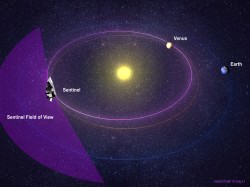This Earth Day, Tuesday, April 22, three former NASA astronauts will present new evidence that our planet has experienced many more large-scale asteroid impacts over the past decade than previously thought… three to ten times more, in fact. A new visualization of data from a nuclear weapons warning network, to be unveiled by B612 Foundation CEO Ed Lu during the evening event at Seattle’s Museum of Flight, shows that “the only thing preventing a catastrophe from a ‘city-killer’ sized asteroid is blind luck.”
Since 2001, 26 atomic-bomb-scale explosions have occurred in remote locations around the world, far from populated areas, made evident by a nuclear weapons test warning network. In a recent press release B612 Foundation CEO Ed Lu states:
“This network has detected 26 multi-kiloton explosions since 2001, all of which are due to asteroid impacts. It shows that asteroid impacts are NOT rare — but actually 3-10 times more common than we previously thought. The fact that none of these asteroid impacts shown in the video was detected in advance is proof that the only thing preventing a catastrophe from a ‘city-killer’ sized asteroid is blind luck. The goal of the B612 Sentinel mission is to find and track asteroids decades before they hit Earth, allowing us to easily deflect them.”

The B612 Foundation is partnered with Ball Aerospace to build the Sentinel Infrared Space Telescope Mission. Once positioned in solar orbit closer to the Sun from Earth, Sentinel will look outwards in infrared to detect hundreds of thousands of as-yet unknown near-Earth objects over 140 meters in size. The privately-funded spacecraft is slated to launch in 2017-18 aboard a SpaceX Falcon 9 rocket.
In addition to Lu, Space Shuttle astronaut Tom Jones and Apollo 8 astronaut Bill Anders will be speaking at the event, titled “Saving the Earth by Keeping Big Asteroids Away.”
The event will be held at 6 p.m. PDT at the Museum of Flight in Seattle, WA. It is free to the public and the visualization will be made available online on the B612 Foundation website.
Want to support the Sentinel mission? Donate online here.


Global Rural Urban Mapping Project came up with a figure of 3% of the planet is urban. Forgive my crude workings but I guess 26 kTs in 13 years would average out at a 0.6% chance of a city killer per year. Of course you can divide that by the number of cities in the world and your own chances of being hit by one are even smaller.
Often quoted as being “the cost of a highway overpass” isn’t a mission like Sentinel worth it if it can identify and help track any NEOs that have the potential to cause damage? Especially since if one does show up, we all know the first outcry will be “why didn’t we see it coming?”
We have known that the impact flux was 2x-3x the often accepted estimates since the end of the first phase of the MRO mission and its MOLA data, followed by LRO and GRAIL. All the data shows that Mars and the Moon have been impacted 3x the amount ordinary photo-geology indicates.
Also the American DoD has been particularly recalcitrant in releasing its data on how often the planet experiences impacts. The sensors DoD uses to detect nuclear explosions also detects bolides passing through the atmosphere. But the data is classified at least TS-LSP.
“Blind Luck”? Ahhh yes… the story of the lucky monkey and the falling coconut! From then on…. he watched the sky.
Cool, yea, really fantastic article. I didn’t need to sleep tonight anyway… or ever again.
Just don’t think about them. There… problem solved.
“The goal of the B612 Sentinel mission is to find and track asteroids decades before they hit Earth, allowing us to easily deflect them.”
Ahh, but of course we still have to develop the MEANS to “easily deflect them”. The technology is probably within our grasp already, but the willingness to expend the funds needed to develop something to intercept one or two of these per year is probably still several years and one catastrophe away.
Once we learn of and can calculate precisely where on earth these asteroids will hit, and can determine that one is indeed going to affect an urban area, there will be much more willingness to spend the funds to do something about it. THAT number is much lower than one or two per year, so will not be nearly as expensive to deal with as opposed to the recent 26 in 13 years.
One wonders where these interceptors might be stationed. We could just keep them here in some big warehouse, ready to blast into space when needed. This would greatly slow down the response time available to intercept any objects that were very close when detected. We might also “station” a few in various orbits around the earth, out at about 11,000 miles away or better, perhaps half way out to geo-synchronous orbit where they would be available on demand to fire up again and be sent to intercept a threatening asteroid.
The nation who sends the first such interceptor(s) up to this orbit would gain a lot of technological bragging rights, and can challenge other would-be technological nations to “send up, or shut up”. Of course, we would hate to see the wrong type of interceptors being sent up — something actually intended to threaten other nations on earth —, and that would be a huge challenge to overcome, possibly a “deal-breaker” for the whole space positioned earth protecting armada . 🙁
We’re not told at what altitudes these explosions occurred. If they exploded at higher altitudes than Chelyabinsk, they’d be less damaging.